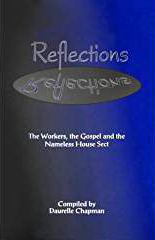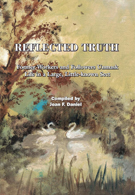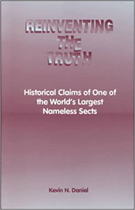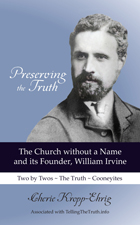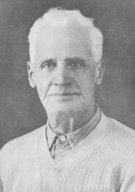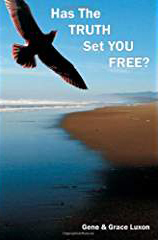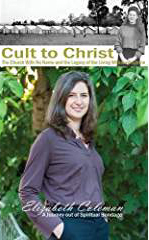Early History of the Work in Scotland
When did the workers first arrive? October 1899, William Irvine took several young men with their bicycles on a mission to Scotland. Pictured are: Jack Douglas, Willie Gill, George Walker, John Hardie, Bill Carroll, Irvine Weir, Warren Hastings. Reportedly, Sam Boyd also accompanied them also. All the men were from Ireland, except John Hardie, Sam Boyd and Wm. Irvine who were from Scotland.
Who were the first brother workers from Scotland? Wm. Irvine 1897, John Hardie 1900, Willie Clelland 1900, Willie Abercrombie 1900, Samuel Boyd 1900, Matt Wilson 1900.
Who were the first sister workers from Scotland? Mary Moodie 1902, Jane Chapman (1903), Maggie Gowans 1903.
Early Workers came from many parts, but places that figure in history include Duns, Kilsyth, and Bathgate. Some 69 others went into the work from the same county (Berwickshire) as Willie Jamieson (Source: statement made by brother worker Craig Jacobsen, USA 2013). Willie Jamieson was from Duns, Wm. Irvine and John Hardie were from Kilsyth.
Who was the first to profess, what year and where? The first Scottish converts were living in the area between Edinburgh and Glasgow.
When & Where was the first Gospel Meeting? One of the first missions worked in the early days was the area around Bathgate (the site of the world’s first oil refinery).
When & Where was the first Sunday fellowship meeting? Probably in Bathgate.
When & Where was the first baptism? Not known for certain. They were baptising at least by 1905, per the May 5, 1905 Kilsyth Chronicle who reported on a baptism of 18 people held at Banton Loch where a crowd of several hundred assembled to watch.
When & Where was the first convention? Possibly at Avonbridge (Falkirk).
Read two undated sermons by Cooney spoken at Avonbridge.
Where have subsequent conventions been held? Avonbridge, Maud, Findochty (Banffshire), Dunbartonshire, Caithness, Pittenweem, St. Monance/Monans, Fifeshire, Chirnside (1911).
In 1927: Monance, Fife; Ayton, Berkwick; Thurso, Caithness; Whitecairns, Aberdeen; Wigton, Cumberland
Where are the conventions now held? Dockray in Wigton, England and two at Gartocharn, Scotland
Northumbria and Cumbria (where Dockray is) are the two most northerly regions in England. Workers’ lists for Scotland show Cumbria and Northumbria under the administration of Scottish workers. Friends are scattered throughout Scotland from the Shetland Islands to the English Border and pretty much everywhere in between, with no high concentrations.
Who have the Overseers been?
Ben Boles until 1916 when he lost his leg in an accident;
Wilson Reid to early 1920’s – see TTT photo
Joe Twamley—see TTT photo
Willie Ross - died July 26, 1971, age 73
Horace Todhunter - see TTT Photo
Frank Simpson -
died August 30, 2004 of cancer
Bob Kerr - see Photo of 2005 European Overseers meeting
Current Overseer: Alan Begg
GO TO: TTT Photo Gallery - view 4 sections for Scotland - scroll down the page
GO TO: Scotland in early Newspaper Articles
Some Early Workers from Scotland
These names are taken from the 1905 Workers List and 1913 Sister Worker's List, plus some others.
Click Here to read testimonial letters for bolded names of Sisters
| Brothers | Sisters |
|---|---|
William Irvine 1897 |
Kate Adamson, 19__, Home: Alloa, Clackmananshire; professed Jan. 1903 |
| Willie Abercrombie 1900 |
Kate A. Allan, 1905 July 21 - Home: Duns, Berwickshire |
| Samuel Boyd 1900 | Jean L. Allan, 1904 June-Home: Duns, Berwickshire; Father Faith Mis rep. |
| John Burns 1905 |
Elizabeth (Pendreigh) Betty 1905 |
| Tom Cameron 1904 | Jessie Campbell 1905 |
| Willie Clelland 1900 | Mary Cook 1905 |
| Tom Craig 1903 | Jane Chapman 1903 |
| Robert Darling 1905 | Elsie Downie 1904 |
| Sandy Dougal 1902 | Maggie Gowans 1903 |
| Frank Downie 1904 | Mary Henderson 1910 - Home: Whiterigg, Ayton, Berwickshire |
| Alex Dunn 1905
|
Aggie Hutchison 1905 - Home: Lauder, Berwickshire |
| Alex Gibson 1905 Harry Gillespie 1905 |
Bella Innes 1908 July– Home: Sandlane, Newmill Keith Banffshire |
| Charlie Glenn 1902 | Elisabeth Jamieson 1905 - Home: Duns, Berwickshire |
| John Hardie 1900 | Violet Jamieson 1905 - Home: Duns, Berwickshire |
| Ralph Henderson 1904 | Martin, Annie 1905 - Home: Philipstown, Linlithgowshire |
| John Hume 1902 | Lizzie McGregor 1904 |
| Tom Haggart 1903 | Annie McNaughton 1904 Home: Doune by Stirling, Perthshire |
| Adam Hutchison 1902 | Kate Meikle – Home: Langrigg, Chirnside, Berwickshire |
| Willie Jamieson 1905 | Lily Meikle - 1904 Home: Langrigg, Chirnside, Berwickshire |
| Jim Jardine 1903 | Mary Moodie 1902 - Home: Sauchie, Clackmannshire |
| Bob Johnston 1905 | Anna Patterson |
| Willie Jones 1905 | Weir, Jean 1906 - Home: Philpstoun, Linlithgowshire, Scotland |
| Joe Kerr 1902 | Bella Kerr 1905 (sister to Joe Kerr) |
| Hugh McKay 1905 | |
| Jim Martin 1904 | |
| Richard Meikle 1902 | |
| George Nelson 1905 | |
| John Paterson 1903 | |
| Tom Patterson 1905 | |
| James Patrick 1903 | |
| Thomas Purves 1905 | |
| Andrew Robb 1901 | |
| Archibald Russell, 1904 | |
| George Samuel 1905 |
|
| Sandy Scott 1909 | |
| Willie Snedden 1905 | |
| Alex Waddell 1905 | |
| Wm Weir 1903 | |
| Joe Williamson 1905 | |
| Matt Wilson 1900 | |
KILSYTH
Home of William Irvine
William Irvine was born in Newtown, Kilsyth, Stirlingshire, Scotland, on January 7, 1863, the third child of eleven children born to John and Elizabeth Irvine. He was raised in the Presbyterian faith at Kilsyth Church of Scotland.
Go to: Information about Kilsyth
Go to: Photos of Kilsyth
On January 8, 1893, when Wm. Irvine was about 30 years old, he unexpectedly experienced a spiritual converstion and "began to serve the Lord" in a revival mission held in the Motherwell Town hall building in Motherwell, Scotland by a well-known traveling Presbyterian evangelist named Rev. John McNeill. This building is still standing and is located southeast of Glasgow at 60 Hamilton Road, Motherwell, Lanarkshire, Scotland. The January 7th and 14th, 1893 issues of Motherwell Times confirm that Rev. John McNeill conducted services in Motherwell during January 8-13, 1893. See photo taken in 1995. (click "next" to see another photo)
After Wm. Irvine was converted through Rev. John McNeill, he attended the John Anderson Bible College in Glasgow. He became a pilgrim with the Faith Mission on June 14, 1895, when he was 32 years old. After training, Irvine began
preaching in Scctland in 1896, and was sent to Ireland in 1896.
Faith Mission is a Protestant evangelical movement founded in 1886 by John George Govan and headquartered in Edinburgh, Scotland. The FM was focused on the evangelization of rural villages, country districts, and small towns in Scotland. Faith Mission is NOT a church or a religion. They do not make converts, baptize or provide communion; they do not set up churches. They are simply a MISSION, as their name indicates. They encourage their converts to attend the Protestant church of their choice.
1899 Bicycle Trip to Scotland. Irvine and several other young men went on a bicycle expedition to Scotland in the fall of 1899 on an experimental mission using Jesus' Matthew 10 instructions to the disciples. All but two of them entered the work later.
Wm. Irvine left the Faith Mission and founded a separate faith ministry in Ireland similar to the Faith Mission. George Walker, Jack Carroll, Ed Cooney, Willie Gill and some others joined him. They rapidly gained volunteers for their 2x2 ministry. Their first convention was held in Rathmolyon, Ireland, in 1903, after which the movement went worldwide with William Irvine, Irvine Weir and George Walker being the first to go to the United States in 1903.
Summary: The Friends and Workers fellowship/church that is still meeting today was started a little over 100 years ago by a Scotsman named William Irvine in Nenagh, County Tipperary, Ireland.
The author personally visited Kilsyth, Scotland in 2004; and returned to Ireland, Scotland and England again in 2014 for research and pleasure.
SCOTLAND CONVENTION TIDBITS
Gowanbank near Avonbridge Convention was held on a farm called Gowanbank in the 1910's or 20's. Avonbridge is a small village in Stirlingshire, about 5 miles southeast of Falkirk at a bridging point over the River Avon, hence the name Avonbridge. It was built in a bit of a rush, mainly with the help of friends who were coal miners during a miners strike. Seems a group of them not working during the strike and not wanting to picket, helped in setting up the convention. Today there are no working deep mines in Scotland. The conv. was only held here for 2-3 years and then moved elsewhere.
St. Monans aka St. Monance aka St. Mohans Convention. At one time the village of St. Monans had about 1,000 inhabitants and at least six fellowship meetings. Now the convention and all other meetings held there have been discontinued. Andrew Morris, the last friend in the village and also elder of the meeting, passed away in 2012. The convention meetings were held in the Town Hall and meals were held elsewhere in a dining tent. The friends were put up in the homes of local friends. Many of the brothers slept at night in the same hall used for meetings during the day. Baptisms were held in the Firth of Forth late at night and early in the morning to avoid curious onlookers. View newspaper article and photo of Baptism in the Sea at St. Monance.
In 1920, St. Monans won the victory and went "dry," and was the only centre in Fife to do so. This was due to there being an unusually large number of religious sects, including such bodies as Plymouth Brethren, Salvation Army, "Cooneyites"...which produced a strong wave of "No License" sentiment." Read How St Monans Went "dry."
Caithness. A convention was held somewhere in Caithness County for a short time (dates unknown). Caithness is THE most northerly county and point of mainland Britain and Scotland.
Pittenweem: A convention was held at Mr. Dye’s home at Priorsgate in Pittenweem for about two years either before or after WWI. Pittenweem is a small secluded fishing village tucked in the corner of Fife on the east coast of Scotland. In the Photo, John Simpson Paterson is lying down on the extreme right and Joe Twamley is on his left. The meetings were held in the Town Hall to the right of the photograph and there was a tent pitched in the garden. The arrangements were not large enough so the convention was moved to St Monans.
Currently, Priorsgate is privately owned, and is listed in the Historic Scotland registry of buildings having special architectural or historic interest. Its property description reads: House early Victorian, 2-storey and attic snecked rubble 3 gabled dormer
heads, slated; garden wall is of much earlier date, rubble-built with
square openings, 18th century rusticated gatepiers.
Chirnside Convention was first held in 1911. Chirnside (pronounced "Chir-sit") is a hillside village in Berwickshire in Scotland, 9 miles west of Berwick-upon-Tweed and 7 miles east of Duns. Chirnside was near Duns, which was home to Willie, Elisabeth and Violet Jamieson. Willie was home from America for the first Convention held at Chirnside in 199, and wrote a letter mentioning Wm. Irvine speaking there. (See letter in TTT Photo Gallery)
Maud Convention was held in the northeast of Scotland, north of Aberdeen in the village of Maud from perhaps 1914? until replaced it was by the Findochty Convention, perhaps in the early 1930's.
Findochty Convention was held near end of April each year, beginning sometime around 1928, and was discontinued around 2004-05. Findochty (pronounced "Fin-eckty") is a small fishing village on the northeast coast of Scotland near the port of Buckie (about 60 miles NE from Aberdeen and 50 miles east of Inverness). The convention meetings were held in the local town hall on Seaview Road. Just a short walk away, meals were served in a tent erected on a piece of land owned by some friends (formerly owned by the Phimister family). Baptisms took place in the sea (Moray Firth) just yards from the tent during normal hours and they sometimes attracted a crowd of onlookers. Those from afar stayed in the homes of the friends living there, and the Scouts Hall was sometimes used for sleeping quarters. Accommodation were originally with friends in the village, but as they died off, and no young people moved to the village, numbers declined. However, those who bought houses that had historically accommodated convention attendees continued to do so. Towards the end, those sleeping there (many commuted from other towns), were staying with folk who had no real connection to the convention. At one time this village had two large Sunday morning meetings. The last remaining meeting in the village Findochty is held in the convention ground owners' home at 17 New Street. View Findochty photos (click "next" from first photo). After WW2 convention was held at Gartocharn.
There was a black and white postcard sold at a general merchants shop at 21 New Street, Findochty showing the convention dining tent which was erected on a large piece of ground at the rear of the house at 17 New Street. The postcards were very popular with the Friends for sending or as souvenirs. (TTT would very much like to have a copy of this postcard)
Gartocharn, Dunbartonshire holds two conventions in June in a tent and many Irish friends attend. The letter "c" is silent in Gartocharn--pronounced: Gart-a-harn.
The village lies within the beautiful Loch Lomond and The Trossachs National Park, within which is Duncryne Hill, known locally as the "Dumpling," which is a tiny hill of only 465 feet (142 metres) above sea level. However the very short ascent reveals a fantastic panoramic view of Loch Lomond, dotted with its many islands and backed by the great mountains of the Southern Highlands.
The convention grounds are located near the bottom of Duncryne Hill. It was/is a common practice for some of the friends to climb Duncryne Hill after lunch (before 2nd meeting). The hill offers superb views over Loch Lomond and its surrounding mountains and is known as "The Dumpling." For walking/hiking directions and map, go to: http://www.incallander.co.uk/duncryne-hill-walk
The convention grounds are located in an old sandstone quarry now pleasantly overgrown with trees in the small village of Gartocharn on the banks of Loch Lomond, about 15 miles northwest of Glasgow. The convention may have started in the 1930’s but would have been suspended during WW2 and resumed afterwards in the 1940s. Various old huts and buildings still exist in the quarry which were home to the evacuated residents of Glasgow who were displaced to avoid bombing from Glasgow where the Clydesdale shipbuilding area was located and which was a target for Germans. The occupation by Glasgow refugees during WW2 was the source of the names many of the huts have even today. Mrs. Taylors, etc. are names of huts today, but were actually the names of the WW2 occupants. Some of these huts are original WW2, but most have been entirely rebuilt in-situ as they deteriorated. The Irish attendance at this convention stems from the period known as the "troubles" in Northern Ireland, when at one stage it was thought unwise to have large conventions there, so many friends went to Gartocharn instead. This became sort of tradition in some families, and while there are local Irish conventions, many still attend Gartocharn, feeling it to be "their" convention. Gartocharn is owned by the Connor family who inherited it from the Cooper family. There are 3 homes there. They have a transport business in the unused quarry.
Dockray aka Dochray or Dockray Hall (name of the farm) is located 1/2 mile west of Wigton in Cumbria, England, just south of the border. Dockray Hall Farm is about 10 miles from Carlisle, on the southern shores of the Solway Firth (river), where many professing families live. Although located in England with English owners, it is regarded as a Scottish convention. The convention has been held there since around 1920. The farm house at Dockray was built in 1699--it states so over the front door. The meetings are held in a tent. Having a Scottish Convention in England sometimes presents a challenges for visiting workers opening remarks, such as, “I’m so pleased to be at this Scottish Convention here in England.” (View Dockray Hall photo)
TIDBITS ABOUT
WORKERS FROM SCOTLAND
Willie, Elisabeth and Violet Jamieson were three siblings from Duns, Berwickshire, Scotland and all three entered the work during 1905 and labored in America. Willie also went to China and other countries was imprisoned during WW2 in the Philippines with four other workers. Willie’s obituary stated:
William Rankin Jamieson was born April 28, 1881, in Scotland, to William and Elisabeth Jamieson. He heard the gospel and made his choice January 2, 1905. Later that month, he entered the ministry. In the fall of that year he came to California to work. He labored in Oregon and Manitoba before going to China in 1926. He spent 6 years in the Philippines, from 1939 to 1945, being interned part of that time. Uncle Willie has been in California since March 1957. He became ill January 11, 1974, and passed away October 11, 1974. The funeral service was October 15, 1974, at 7:00 p.m. in Whittier, California. The interment was October 16 at 10:00 a. m., Pacific Crest Cemetery, Redondo Beach, California.
Click Here to read many more details about Willie Jamieson and his sisters.
View photos of Jamiesons.
About his tour of Britain in 1985, the late Sydney Holt wrote: “On Saturday Robert took me about 15 minutes ride to just outside the town of Duns where we saw the home where Uncle Willie Jamieson was raised and the hills where his dad shepherded sheep. Drove down the road Uncle Willie walked down after he said goodby to his parents who weren't in agreement with his going forth to preach. Also saw the spot where he sat down and looked back wondering if he were making the right choice! Then the train depot (not in use now) in Duns where he caught the train…We then drove to Chirnside, where Uncle Willie worked for a butcher in his shop. Saw the very hall in Reston where Uncle Willie first heard the truth at a special meeting! In Chirnside we saw the farm where the first convention was held (1911) in this part of Scotland.”
Read all 7 letters by Sydney Holt
On a tour of Britain, Craig Jacobson wrote:
John Hardie (often misspelled “Hardy”) was a Scotsman from Kilsyth, Stirlingshire, Scotland born in 1870 to William B. & Isabella Hardie. John was an old friend of Wm. Irvine."David Newlands, Duncan Hunter's nephew in the work here in Scotland…drove me through the district where Willie Jamison first listened to the workers around 1904 or '05, made his choice after his first meeting, then started out in the work three weeks later. We also saw the old stone 3-home terrace structure that was the home he left to go in the work. It is up on the side of a hill, surrounded by pasture, looking down on the village.
We later went to the village where Willie had his first mission with his first companion. In this village we saw the stone home where the Hunters lived at the time, grandparents to Duncan. We saw the old stone church where the Hunters attended before hearing the message brought to them by the workers.Also, outside the village we saw the place at the creek where Willie was baptized along with the first converts from the mission, including the Hunters. Within a few months Willie left by ship for California to share the good news of the gospel in areas to later include Oregon.
At the height of the British Empire, as the 1800's ended and during the first few years of the 1900's Scotland, Ireland, Wales and England were all working together as a political unit. Glasgow Scotland was the industrial center known for ship building. During these years the early workers began preaching in these lands. The response was good in Scotland in those days. Many stories could be told if known. Many the unknown soldier in the spiritual warfare of the kingdom. Some 69 others went into the work from the same county as Willie...God knows their stories."
John joined Wm. Irvine's band of workers in 1900, coming over with a few other workers from Todd's Mission when Todd abandoned it. Some time later, John's wooden meeting hall was maliciously burned down in Kilkenny, Ireland. John was said to have used the money awarded by the court for damages to pay his passage to Australia. In July, 1904, John and Sandy Alexander arrived at Melbourne, Victoria, and were the first workers to arrive in that state. John and Dick McClure came to Sidney in 1907 and pioneered the movement in New South Wales. John was the overseer of NSW until his death in 1961. Read Account of John Hardie pioneering Australia.
Willie Clelland, Wm. Irvine’s cousin from Kilsyth, Scotland, knew “John Hardie since I was knee high to a duck. John was a fitter and learned his trade at Twetcher Engineering Shop and became an engineer repairing locomotives. I can remember John as a young man, and I remember well when John was converted. The reason I remember this is because I had a brother and a sister and my own mother who professed in the same meeting John was converted in, a meeting which was fully connected with the churches, the Faith Mission. This meeting was conducted by two women workers, one of whom was Miss Smellie and the other a Miss Harris.” They attended prayer Union meetings together for several years. Wm. Clelland also stated: “This belief was wholly and solely founded by William Irvine and if John Hardie says otherwise, he is lying.” (Source: A Spiritual Fraud Exposed)
Mary Moodie: John Long wrote in June, 1902: The Sister (?) who asked me over to Sauchie for a change of air, also the Brother, John Patterson (?), whose home I lodged in while I was in the district, both soon after that gave up their situations to go fully on the work of the Lord.
The "Sister" John wrote about was very likely Mary Moodie , who was from Sauchie—for she wrote: "In January 1901, two Evangelists came to the village of Sauchie, Clackmannashire, (where I was then residing with my brothers and sisters) and laboured for a few weeks in the district, visiting the people and holding Gospel Meetings. From the first time I heard the Senior worker address a company of people, I was assured he was sent of God, and the ring of Truth and Sincerity found an echo in my life…I did not meet any of the workers for twelve months when I again had fellowship with them in the Christian Conference held at Kilsyth. This convention would have been Jan. 1902." Mary entered the work in 1902. Click Here to read Mary’s 1913 Testimony letter and affidavit on TTT
Richard, Katie and Lily Meikle were from Langrigg, Chirnside, Berwickshire, Scotland, and was probably where the Chirnside convention was held. Richard entered the work in 1902 and arrived in America in August of 2015, age 42 . Soon after he went to Oregon to preach. He died in 1951. His sisters Katie and Lily entered the work sometime after the July 1905 Workers list was printed.
Todhunter Family: Out of a Scotland family of nine children, six went in the work. They were:
Molly Todhunter Scotland died June 2003
Dolly Todhunter - England on 1991 Workers List
John Todhunter - England
Bert Todhunter - Poland, etc. - see TTT Photo
Horace Todhunter – Overseer of Scotland
Mabel Todhunter
The Three Jardine Brothers: John and Elizabeth Jardine had five children all born in Lesmahagow, Lanarkshire, Scotland; three sons and two daughters. Nicol, James (Jim) and Walter all became workers. Daughter Maggie married Mr. Blakke and settled in Minnesota in USA and Agnes remained in Scotland. Like their father, the three brothers had been coal miners before they went in the work.
James was born August 9, 1884 and went in the work in 1904, age 21. Shortly thereafter, he left for America. He was the overseer of Minnesota, from 1940 til his death in 1969. James was considered to be one of the three territorial Overseers in America (Jack Carroll, George Walker being the other two) and had the oversight of the North Central States (Wisconsin, Minnesota and North Dakota). James Jardine died January 6, 1969.
James knew several languages and pioneered the work in Switzerland and Germany in 1913 with Otto Schmidt (of Australia). He also wrote poetry and has quite a few hymns to his credit. He wrote the following which are found in the Hymns Old & New 1987 Edition: Nos. 9, 11, 13, 20, 41, 73, 97, 98, 99, 127, 164, 173, 221, 299, 357, 411, 412; and Nos. 279 and 324 in the 1951 Edition.
Nicol Jardine was head worker in Wisconsin from about 1907 until he died in 1954.
Walter Jardine was over the work in North Dakota at least from 1922, perhaps earlier.
Photos of 3 brothers in TTT Photo Gallery:
Photo 1
Photo 2
Photo 3
Click Here to read more about Jardines
Tidbits about Scotland
Crovie, Scotland (pronounced locally as "Crivvie") is a small seaside village with no road access to many of its houses which clings to a ledge between the bottom of a cliff and the sea. Back in the early 1900’s, workers held meetings there and the majority of the village professed. Several Sunday meetings were held in this tiny village of only 40 houses. Back then, more than every second house was a professing home. Now most houses there are just holiday homes. Read more about this quaint place on the Undiscovered Scotland website.
See gorgeous google photos of picturesque Crovie
R. L. Allan & Sons, Publisher, went in business in 1863 and publish Hymns Old and New and the Oxford Bibles for the friends and workers. For over 125 years they were located in Glasgow, Scotland. They recently relocated to Tolworth, Surrey, England in the Greater London area. Click Here to view their website.
TOURING SCOTLAND
When will you go? – some times of the year are far better for some types of event.
What do you like to do? Culture, Scenery, Sports, Hike, Learn History?
Who can advise you which attractions are well advertised but not really the best, and which are not so well publicised, but are not to be missed?
The following is to help guide you to get the best out of your visit to Scotland.
Getting about Scotland
Scotland isn’t a huge country by standards such as say USA or Canada, but the roads in some places make it slow getting around. It would take about 18 hours to drive non-stop north to south on the mainland. Taking in the Islands adds days. There are good train services, but they don’t cover the whole country, and some attractions are out of easy train reach. Flying is normally only for getting to the islands, though there are many flight connections to all parts of England. A car will get you anywhere, but if you want to see a lot you’ll need about two weeks. If you’ve only got a week, then you probably need to decide between the two main geographic areas, the lowlands or the highlands. The main population lives in the lowlands, and especially in and between the two main cities of Glasgow and Edinburgh.
If staying a week or more, and using trains, buy a special fare card, and travel by bus, ferry or rail. http://www.scotrail.co.uk/content/feedom-scotland-travelpass.html
History
Rich in history, the country has more castles and stately houses that you could ever visit. Not all are open to the public. Best value castles include Stirling and Edinburgh Castles.
Click Here for more historical information.
Food
Food defines many countries, and Scotland is no different. From its local fish, including salmon, to traditional dishes such as Haggis, Scotland’s food offering can satisfy the most critical foodies. Restaurants range from the top line such as Gleneagles and Champanay to more middle of the road.
Culture
Highland Games are a mixture of history, culture and sport. Most towns have a highland games, not only in the highlands. Held in the summer months, typically weekends, well worth a visit to see traditional Scottish events such as “tossing the caber.”
Music features strongly too, and all year long there are concerts and gatherings of various genres, but especially popular are Celtic festivals. Special mention to Speyfest, (August) the Celtic Connections, (winter) and Edinburgh Festival (August)
Edinburgh Festival is a unique event that virtually takes over Edinburgh each August. Here you’ll find several thousand events spread all about the city from very formal to absolutely informal street events, staged by performers from all over the world. It's not all plain entertainment. There’s film, art, science, book, jazz and other festivals, all running concurrently. It's possible to attend events end to end all day long. A highlight of this time is the Edinburgh Tattoo, a military style musical extravaganza held in the grounds of Edinburgh Castle. Book for this several months in advance.
See http://www.edintattoo.co.uk/
http://www.edinburghfestivals.co.uk/festivals/international
http://www.celticconnections.com/
Scenic Attractions
Scotland’s scenery has to be seen to be believed. The highlands are perhaps more scenic, and certainly less populated, but there’s more ground to cover to see it all.
Hill and Country Walking/Hiking
There are well defined walking tracks through all varieties of countryside, from alpine to maritime. There is freedom to roam in Scotland, meaning there’s almost nowhere you can’t walk. Mountain walking and climbing in winter can be very challenging due to fast changing weather, so seek advice and go prepared.
Click Here for more info.
Hiking Etiquette 101: The 12 Trail Rules You Should Know
Sporting
Scotland is the home of Golf, and you will not be able to miss seeing many golf courses. There are over 600 courses. Some are exclusive, many expensive, all enjoyable. Many have hire clubs, most welcome visitors. Advisable to book ahead. Other sporting activities include Horseriding, Extreme sports, Whitewater rafting, snow skiing/boarding, sailing, mountain biking etc. There’s something for everyone.
Click Here for more info.
TTT Editor's Note: In the absence of a written account, the above information has been compiled by the TTT Editor from various sources. Corrections or additions are most welcome; as well as other historical accounts for this country
Email TTT

 REPRESENTING THE LARGEST COLLECTION OF 2X2 HISTORICAL DOCUMENTS ON THE INTERNET
REPRESENTING THE LARGEST COLLECTION OF 2X2 HISTORICAL DOCUMENTS ON THE INTERNET
 Perry, Oklahoma Conv, 1942
Perry, Oklahoma Conv, 1942
